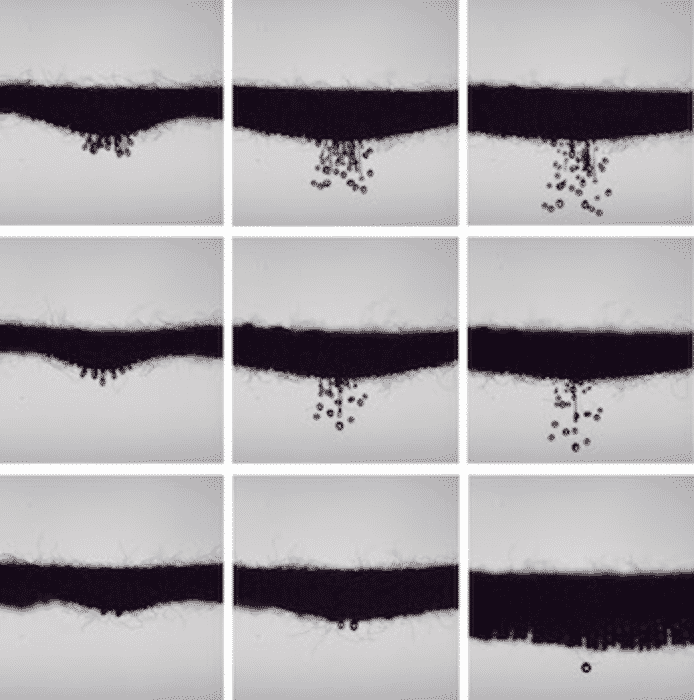Future Masks With Hy-Cu Filter, One-Stop Answer To The Piling Mask Wastes
Developing good air filters could potentially avoid a future pandemic. During the 74th Annual Meeting of APS (Americal Physical Society) DVD (Division of Fluid Dynamics), researchers are going to present the recent findings on the functioning of future face masks, the effect of these masks when exposed to water, and reasons for following a proper usage of masks.
During a live online conference to be conducted on November 23rd, 2021 (Tuesday), they will discuss the results and address the press queries. The virtual press briefing will be held for one hour according to the US MST (Mountain Standard Time) from 12 p.m. to 1 p.m.
Prior to launching the future masks to the market, researchers from the UofT (University of Toronto), IISc (Indian Institute of Science), and UCSD (University of California San Diego) have focussed on the risks and functions of our current face masks.
An engineering professor from UCSD, Abhishek Saha, planned to address a simple yet prevalent issue, i.e. damp masks.
He questioned the efficiency of the mask after wearing it for a long time. Dampening of the mask is clearly attributed to the condensation from breathing. He further questioned whether this will affect the functioning of the masks.
Saha will discuss the recent outcomes of a study that evaluates two distinct kinds of masks gradually getting wet. He will explain whether the efficiency of maks in catching respiratory droplets is getting affected by this progressive wetting. Further, he will present how mask-fitting is altered upon using it for a long time, leading to leakage through the sides.
The findings on wet masks will be published in the journal, Physical Review Fluids.
In the latest research article, the scientists also studied dry masks. Saha added that respiratory droplets of bigger size quickly settle on the ground because of the gravitational force. Therefore, these droplets are considered less harmful. However, in the case of a dry mask, they discovered that even respiratory droplets of bigger size can penetrate the matrix of the mask and generate several small droplets with more airborne lifetime. Improper usage can lead to the atomization of these large droplets.
In the meantime, other researchers have focussed on devising a novel type of filtration system for masks.
Majed Jafar Diab, the speaker for elucidating how future face masks may work in the upcoming event and who is a mechanical engineering student at SDSU (South Dakota State University) mentioned that they are employing tortuous nasal cavities of animals as a model to come up with ideas for a novel filter system that can efficiently filter airborne particles and function with relatively low-pressure gradients, which determines the amount of energy used.
With CT scans, the researchers observed the internal nasal cavities of rabbits, guinea pigs, possums, dogs, pigs, and potoroo- a rat-like creature associated with the kangaroo eucalyptus-loving greater glider, and Australian marsupials: a small cat known as the northern quoll.
The scientists later developed the design and printed 3-D filters- which can be easily drawn in the air when compared to the current masks- and evaluated them in a wind tunnel.
SDSU’s professor who worked with Diab, Saikat Basu mentioned that apart from the development of masks, this bio-inspired design for filters can be employed to develop large-scale baffles for use in industries as well as for clean air generation in crowded & confined spaces.

The study is co-supervised by Basu together with Leonardo Chamorro from UIUC (University of Illinois Urbana-Champaign) and Sunny Jung from New York’s Cornell University.
During a conference, the research team will share the latest findings along with the temperature gradients used to kill the trapped virus particles along the surfaces of the filter
Another group from UNAM (Universidad Nacional Autónoma de México) and Purdue University has designed a face mask that can inactivate the virus and be reused.
The layers of the Hy-Cu filter comprise a mesh made of copper which is coated with carbon similar to diamond. This carbon coating kills the virus particles within a couple of hours. Due to the filter’s adherence with any scarf or cloth mask, it is consumer-friendly.
Tanya Purwar, who is going to present the preliminary results of future masks with Hy-Cu filter and who is a graduate student at Purdue University majoring in experimental fluid mechanics explained that the Hy-Cu filter makes cloth masks sustainable, reusable & safer, and is easy to breathe through- a wise substitute to the current disposable masks that daily create huge heaps of wastes.
Purwar and her teammates evaluated both disposable face masks and the newly developed filters against the live MS2 virus. They will share the recent findings concerning the enhanced efficiency of the Hy-Cu filter in inactivating the virus when compared to today’s disposable face masks. The study demonstrated previous computer predictions on filter usage.
Purwar claimed that this novel filter has been compared to control and tested for killing the virus within 2 hours. The study showed remarkable results and explained how future face masks may work.
Future Masks With Hy-Cu Filter, How Future Face Masks May Work?
Interesting Finds Across The World:



